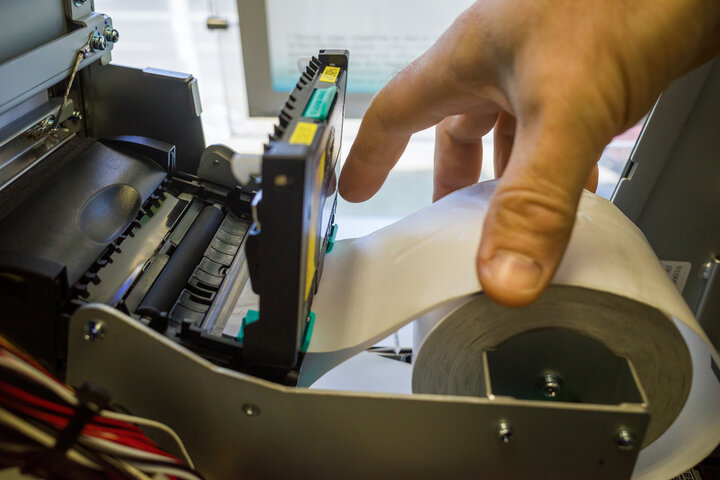
Thermal paper is everywhere—receipts, tickets, medical prints, and more. But did you know using the wrong size can cause printer issues?
Selecting the correct thermal paper size ensures smooth operation, reduces paper waste, and improves printing efficiency. Different industries rely on specific sizes for their needs.
In this post, you’ll learn why thermal paper size matters, common dimensions, and how to choose the right one for your device.

Key Measurements of Thermal Paper Rolls
Selecting the right thermal paper roll requires understanding four essential measurements: roll width, roll diameter, roll length, and core size. These factors determine compatibility with your printer and impact printing efficiency. Below, we break down each measurement and why it matters.
Roll Width
Roll width refers to the distance across the face of the thermal paper roll, measured from one edge to the other. It is the most critical measurement because incorrect width can prevent the paper from fitting into your printer.
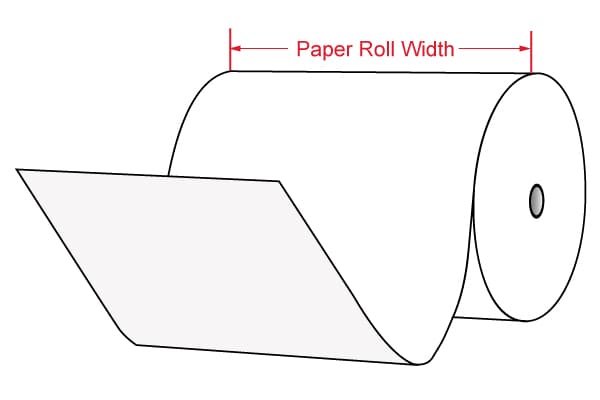
How to Measure Roll Width Correctly
Lay the roll flat on a surface.
Use a ruler or caliper to measure across the entire paper width (not just the printed area).
Measure in millimeters for accuracy.
Common Thermal Paper Roll Widths
Thermal paper rolls come in various widths to accommodate different devices and applications. The most common widths are 2 1/4 inches (57mm) and 3 1/8 inches (80mm), while less common sizes like 4 inches (102mm) cater to specific industries and use cases.
2 1/4 inches (57mm)
Widely used in small POS systems, portable printers, and credit card terminals
Suitable for compact devices and space-saving applications
Conversion: 2 1/4 inches = 2.25 inches = 57 mm
3 1/8 inches (80mm)
Commonly found in larger POS systems and commercial ticket printers
Offers a wider print area for more detailed receipts and tickets
Conversion: 3 1/8 inches = 3.125 inches = 80 mm
Other Less Common Widths
Roll Diameter
The roll diameter is the total size of the paper roll when measured from one side to the other, passing through the center. It determines how much paper is on the roll and affects how frequently it needs replacement.
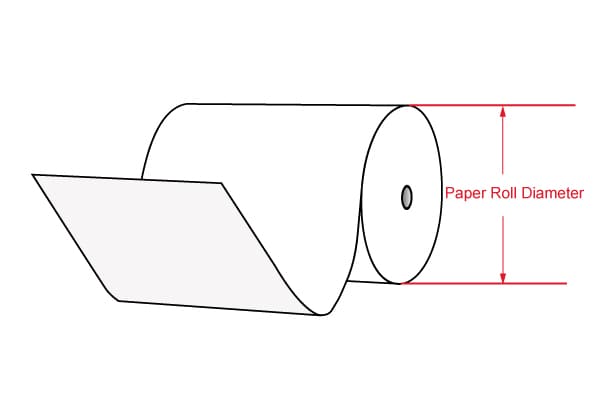
How to Measure Roll Diameter
Place the roll on a flat surface.
Measure the distance across the roll from one edge to the other.
Ensure the measurement passes through the core.
Typical Diameter Ranges
Small rolls: 30mm – 80mm (Used in handheld or compact devices)
Medium rolls: 100mm – 150mm (Standard POS systems)
Large rolls: 200mm – 250mm (High-volume printing)
Considerations When Choosing Roll Diameter
Ensure the roll fits within the printer's compartment.
Larger diameters provide more paper but may not be compatible with all printers.
Some printers have specific diameter limitations, so always check your device’s specifications.
Roll Length
Roll length refers to the total amount of paper wound onto the roll. It directly affects how frequently the roll needs replacement—longer rolls last longer but require a printer that supports them.
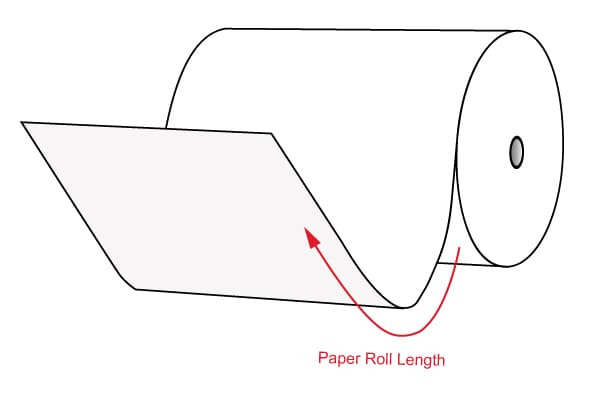
Factors Affecting Roll Length
Paper thickness: Thinner paper allows for longer rolls with the same diameter.
Core size: A larger core reduces the total paper length.
Printer capacity: Some devices can only handle specific roll lengths.
Common Roll Lengths
| Length (Feet) | Length (Meters) | Usage |
| 50' | 15m | Small POS terminals, mobile printers |
| 80' | 25m | Moderate printing needs |
| 185' | 56m | Retail, hospitality industry receipt printing |
| 220' | 67m | High-volume retail and restaurant environments |
| 230' | 70m | Supermarkets and busy checkout stations |
| 273' | 83m | Industrial applications |
How Roll Length Impacts Replacement Frequency
Shorter rolls require frequent replacements, leading to potential downtime.
Longer rolls reduce the need for frequent changes but require a compatible printer.
Finding a balance between roll length and printer capacity optimizes efficiency.
Core Size
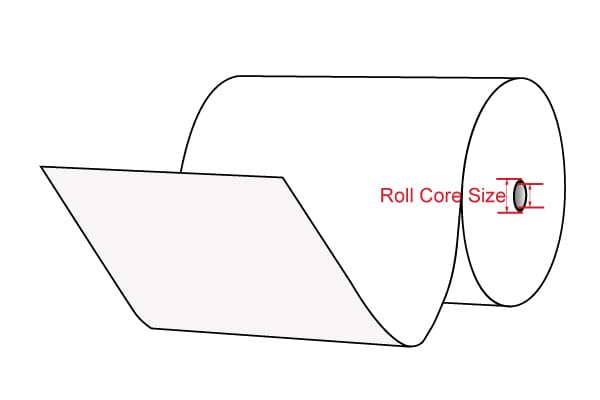
The core size refers to the diameter of the tube onto which the paper is rolled. It consists of two measurements:
Core I.D. (Inside Diameter): The size of the center hole in the core, which must match the printer's spindle or pin holder size for proper function. The standard core I.D. is 12.7mm (7/16").
Core O.D. (Outside Diameter): The size of the entire core, which is less critical than the core I.D. but influences the roll's diameter and footage.
With the advent of modern printers and EFTPOS terminals, the importance of core size has diminished, as many devices no longer require spindles to support the roll. However, it's still essential to consider core size when purchasing thermal paper rolls to ensure compatibility and cost-effectiveness.
Understanding Thermal Paper Roll Measurements
Choosing the correct thermal paper size requires understanding how roll dimensions are expressed and why accurate measurements matter. Using incorrect paper sizes can lead to printer malfunctions, wasted supplies, and inefficiency in business operations.
Standard Format for Expressing Roll Dimensions
Thermal paper rolls are typically measured using the format "Width x Length." This format clearly indicates the two most critical dimensions of the roll.
For example:
Here's a quick reference table for common thermal paper roll sizes:
| Roll Size (Width × Length) | Width (mm) | Length (m/ft) | Common Usage |
| 2 1/4" × 50' | 57mm | 15m (50ft) | Credit card terminals, mobile POS printers |
| 3 1/8" × 230' | 80mm | 70m (230ft) | Retail POS systems, standard receipt printers |
| 4" × 103m | 102mm | 103m (338ft) | Industrial label printing, specialized applications |
Importance of Accurate Measurements
Obtaining accurate measurements is essential when selecting thermal paper rolls for your specific device or application. Here's why:
Printer Compatibility: Each printer is designed to accommodate specific paper roll dimensions. Using a roll with the wrong width or a diameter that's too large can lead to paper jams, poor print quality, or even damage to the printer.
Functionality: Choosing a roll with the correct width ensures that the printed content fits within the designated print area, while the appropriate length determines how frequently the roll needs to be replaced.
Cost-Effectiveness: Accurate measurements help you select rolls that maximize the paper's usage, reducing waste and minimizing the frequency of roll replacements.
How to Measure a Thermal Paper Roll Correctly
Measure the width: Use a ruler or caliper to measure across the full width of the roll.
Determine the roll length: Check the manufacturer’s label or calculate based on roll diameter.
Verify the core size: Measure the inside diameter (I.D.) of the roll’s core if your printer requires a spindle.
Converting Between Inches and Millimeters
Thermal paper roll sizes are commonly measured in both inches (U.S. standard) and millimeters (metric system). Understanding how to convert between these units is essential for ensuring compatibility with different printers and international suppliers.
Conversion Formulas
To convert inches to centimeters or millimeters, use the following formulas:
Keep in mind that 1 centimeter equals 10 millimeters, so you can easily convert between centimeters and millimeters by multiplying or dividing by 10.
Examples of Common Conversions
Let's take a look at some common thermal paper roll widths and their conversions from inches to millimeters.
2 1/4 inches to millimeters
To convert 2 1/4 inches to millimeters, first convert the fraction to a decimal:
Then, apply the inches to millimeters formula:
In practice, this width is often referred to as 57mm.
3 1/8 inches to millimeters
To convert 3 1/8 inches to millimeters, follow the same process:
This width is commonly known as 80mm in the thermal paper industry.
Here's a quick reference table for these common conversions:
| Inches | Millimeters | Commonly Referred To As |
| 2 1/4 | 57.15 | 57mm |
| 3 1/8 | 79.375 | 80mm |

How to Choose the Right Thermal Paper Size
Selecting the correct thermal paper size is essential for smooth printer operation, reducing waste, and ensuring clear, high-quality prints. Using an incompatible roll can lead to printing errors, paper jams, and unnecessary expenses. Below is a step-by-step guide to help you choose the right thermal paper for your needs.
Step-by-Step Guide to Selecting the Right Thermal Paper
Identify your printer model and its specifications:
Consult your printer's user manual or look for the model number on the device itself.
Check the manufacturer's website for the printer's specifications, including recommended paper sizes.
Determine the correct width for your device:
2 1/4 inches (57mm): Used in small POS systems, portable printers, and credit card terminals.
3 1/8 inches (80mm): Typically used in larger POS systems and commercial ticket printers.
Consider roll length based on printing needs:
Evaluate your printing volume and frequency to determine the appropriate roll length.
Longer rolls, such as 230 feet (70 meters), are suitable for high-volume printing environments.
Shorter rolls, like 50 feet (15 meters), are ideal for low-volume or portable printing applications.
Choose a roll length that balances convenience and cost-effectiveness for your specific needs.
Check core size compatibility:
Verify that the core size of the thermal paper roll matches your printer's requirements.
The most common core size is 7/16 inches (12.7mm), but some printers may require different sizes.
Ensure the core size is compatible with your printer's spindle or paper holder to prevent issues during installation and use.
The Importance of Choosing High-Quality Thermal Paper
In addition to selecting the correct size, it's essential to choose high-quality thermal paper for your printing needs. High-quality thermal paper offers several benefits:
Durability: High-quality thermal paper is less likely to fade, discolor, or become brittle over time, ensuring long-lasting printouts.
Clarity: Superior thermal paper produces sharp, clear, and easy-to-read text and images, enhancing the overall quality of your printed materials.
Smooth feeding: High-quality thermal paper reduces the risk of paper jams and ensures smooth feeding through your printer, minimizing interruptions and downtime.
Compatibility: Choosing thermal paper from reputable manufacturers ensures compatibility with your specific printer model, optimizing performance and print quality.
Conclusion
Choosing the right thermal paper size is essential for smooth printing and cost efficiency. Width, length, diameter, and core size all matter.
Using incorrect paper can cause jams, misalignment, and frequent replacements. Always check your printer’s specifications before purchasing rolls.
A well-matched roll improves print quality, extends printer life, and reduces waste. Selecting high-quality thermal paper ensures durability and clarity.
For more details on thermal paper sizes, contact Sunrise. They offer various options and can help you find the right fit. Visit Sunrise Paper to learn more.






























